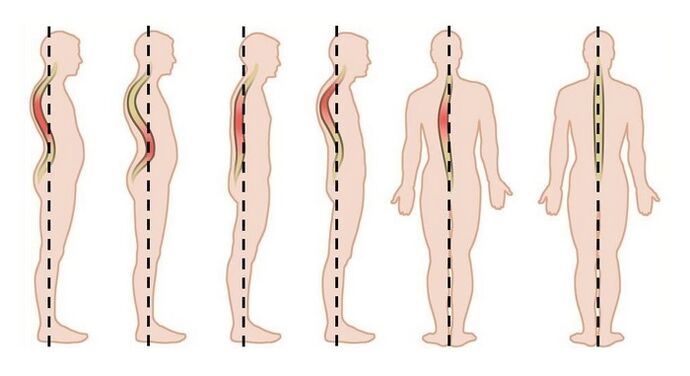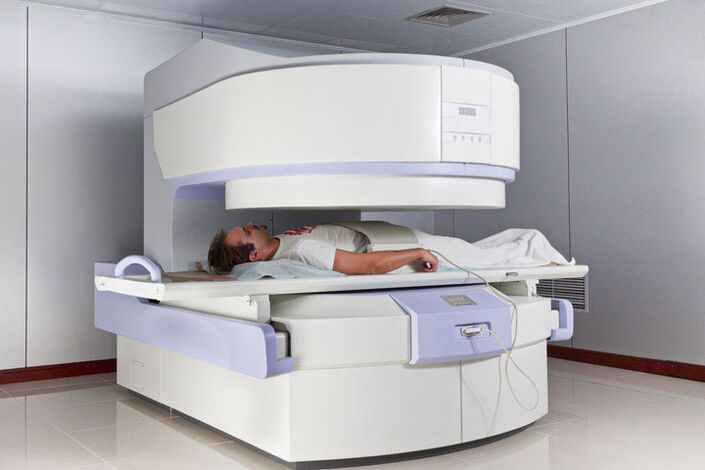
Osteochondrosis is one of the most commonly diagnosed spinal diseases. This pathology has the origin of degenerative dystrophy, affecting the intervertebral discs, leading to their structural and external changes. Doctors define three types of diseases: cervical, thoracic, and lumbar osteochondrosis, depending on the location of the spine disease. If we talk about the statistical data of the identified pathology, I believe that sternal osteochondrosis is less common than other types. This is due to the peculiarities of the human spine structure in the thoracic region: the movement of the intervertebral discs in this part of the back is limited, which significantly reduces the possibility of them suffering from trauma.
What is thoracic osteochondrosis
Recognizing this disease is difficult because its symptoms are usually similar to pathological changes in other organs: heart, stomach, etc. The consequences of sternal osteochondrosis are dangerous, so its early detection provides more opportunities for timely correction and prevention of adverse consequences. The disease is also often diagnosed in patients of both sexes of different ages, including children. Let us learn more about the causes, symptoms, medical treatments and home treatments of chest osteochondrosis.
Thoracic spine osteochondrosis itself manifests itself as a degenerative dystrophic disease of bones and vertebral cartilage tissues, which will trigger the development of destructive processes in them. In addition to the vertebrae themselves, the intervertebral discs are also affected: they are layered and reduced in size, so the nerve endings in the intercostal space are squeezed. All these together affect the normal function of the spine. Starting treatment at the wrong time made the situation worse, and then it could only be solved with surgery. For various reasons, the patient could not always solve it.
Osteochondrosis of the chest can cause the development of quite serious and dangerous diseases and conditions. It often causes pulmonary sclerosis, vascular stenosis, genitourinary system dysfunction, and cancer pathology. If osteochondrosis progresses rapidly, this usually limits a person's physical ability: it is difficult for him to walk, work, and do his things freely. Usual activities.
With the development of osteochondrosis, the bone composition of the vertebrae is affected first, then cartilage, and finally connective tissue and adjacent muscles.
If the signs of osteochondrosis appear in childhood or adolescence, adolescence, then this is a dangerous situation because it indicates that the human musculoskeletal system is beginning to age without being fully formed and developed. Thoracic osteochondrosis in children is rarely diagnosed. However, the detected diseases often indicate the presence of other dangerous diseases.
The detection rate of pathology in men and women is about the same. There are also no age-specific priorities. But it is worth noting that women are more likely to suffer from this disease during the period of hormonal changes in the body-menopause.
If you start treatment for thoracic osteochondrosis at an early stage, the chances of the treatment producing positive results are much greater.
The extent and characteristic symptoms of the disease
The development of thoracic osteochondrosis is gradual, and several stages are different. In order to properly organize the treatment process, it is necessary to understand the mechanism of its development and progress.
- The initial stage of the degenerative dystrophy process that occurs in the spine is characterized by a slight reduction in the size of the intervertebral discs. Small cracks began to appear on the surface of the annulus fibrosus of the intervertebral disc. The intervertebral disc may extend slightly beyond the spine. At the same time, first-degree thoracic spine osteochondrosis does not manifest as pain, and usually one does not know an initial dangerous disease. With the help of computed tomography, herniated discs (their slight loss) were detected.
- If a person has grade 2 thoracic osteochondrosis, he begins to experience pain in the back of the chest area. This is explained by the fact that the nerve fibers are squeezed. The muscular ligament organs on the back, the muscular corset, provide the best support for the spine with the correct anatomical shape. In order to prevent spinal instability, it is extremely important to form the muscular structure of the back symmetrically. Otherwise, not only the posture is violated, the spine is bent, but also its individual elements are overactive. It is precisely because of the increased mobility of the vertebrae that the nerve fibers leaving the spine through the intervertebral space are squeezed. How does osteochondrosis manifest in the second stage? The second stage of thoracic osteochondrosis is bound to have back pain. It has different characteristics: it can pull in the form of epilepsy for a long or short period of time. Because the nerve endings are compressed directly in the muscles, the muscles are often in increased tension, which is even worse.
- The morphological signs of thoracic osteochondrosis of the third degree are very obvious, and they affect all the structural anatomical components of the spine. The patient’s pathological pictures are as follows: herniated disc, inflammation of muscles and ligaments, tear marks, displacement of vertebrae, and symptoms of vertebral joint disease. The clinical manifestations of the third stage spinal disease are very diverse. In addition to the fact that a person does have pain in thoracic osteochondrosis, the patient also loses the tactile response of the body part through which the damaged nerve passes; he has an autonomic nervous system disease with respiratory and circulatory dysfunction. He has trouble breathing, heartache, irregular heartbeat, and shortness of breath. In addition, the patient has joint arthropathy of multiple joints at the same time, and the function of the organs in the chest area begins to appear pathological obstacles. When the intervertebral fissure reduces its height by two-thirds, similar symptoms occur. Its size is assessed by chest X-rays, and it is performed in two projections: straight and lateral.
- As spinal degenerative disease develops into fourth-degree osteochondrosis, the intervertebral space is reduced to a minimum distance, such as spondylosis, spondyloarthropathy (characterized by intervertebral joint disease), spondylolisthesis (vertebral distortion or displacement). The body mobilizes its compensatory ability to reduce the static and dynamic load on the spine to prevent damage to anatomical components, so that the vertebrae grow, flatten and grow with each other. The damaged area of the annulus fibrosus is replaced by bone structure, forming osteophytes (osteophytes). Due to the prolapse of the intervertebral disc, the spinal cord is narrowed, the nerve endings are strongly compressed, the movement of the thoracic spine is weakened, and the spine is obviously restricted. The chest area of the patient continues from the back. Hurt.
- Due to the progress of the disease, the patient has low back pain (back pain), complete or partial paralysis of the legs, and the person loses the ability to work and becomes disabled.
The various symptoms of the disease depend on various causes, including a person’s genetic predisposition. The same symptoms of thoracic osteochondrosis fail in different ways in different patients. There is an objective explanation for this: various reasons, occurrence conditions and general conditions of human health can cause osteochondrosis. Symptoms of thoracic osteochondrosis in men appear earlier than women. The main reason for this phenomenon lies in the physiological structure of the female body: the hormone estrogen protects the intervertebral discs. Therefore, during the period of hormonal background changes (pregnancy, menopause), particularly favorable disease conditions appear.
Many people are interested in whether they were brought into the army due to osteochondrosis. If the conscript has first-degree osteochondrosis, he will be drafted into the army. If young people have obvious symptoms of disease, neuropathologists will observe, then it is likely to be delayed, and in a neglected state (if there is thoracic multi-segment osteochondrosis), they may not call at all.
The reason
The sternal osteochondrosis at the beginning of the disease actually did not show any signs. However, you need to know why it appears. The following causes cause pathology:
- Because professional athletes or people involved in sports perform active strength training without the necessary load control, the spine often suffers from static or dynamic overwork.
- Traumatic damage to bones and spinal joint components usually causes them to fail to fuse properly and collapse quickly. Any spinal injury will be aggravated by pathological changes in the structure and function of the nervous and circulatory system. The nutrient supply required by the bones will usually be restored over a long period of time.
- Poor posture, congenital or acquired spine curvature, resulting in an unbalanced effect on the intervertebral disc.
- When most of the load falls on the chest area of the back, the weight is increased sharply. If a person often performs such exercises, then the possibility of chest osteochondrosis is very high.
- Disorders of the endocrine system. When the metabolic process in the body is disturbed, all other organs and tissues cannot get the necessary nutrients, and their regeneration is also incorrect.
- A genetic prerequisite for possible pathological processes in vertebrae and intervertebral discs. In this case, thoracic osteochondrosis is manifested at any age.
- A person's physical activity and lack of physical activity, sedentary work. In this case, the muscle structure of the back becomes weak, the tissue nutrition deteriorates, the flexibility of the spine decreases, and the risk of thoracic osteochondrosis is significantly increased.
- All tissues of the musculoskeletal system are underdeveloped, leading to spinal degenerative diseases. The reason is the imbalance and excessive load on the spine.
- Various pathological changes of the intervertebral disc. They will become thinner, or conversely they will grow, osteophytes will appear on them, interfere with the function of joints, and destroy blood vessels and put pressure on nerve fibers. The development of intervertebral hernia often causes the progression of osteochondrosis.
- Inflammatory processes in the spine or nearby muscles often cause signs of thoracic osteochondrosis in women and men.
- The blood supply to the spinal cord is impaired due to narrowing or squeezing of veins and arteries.
- The consequence of infectious diseases is the development or deterioration of osteochondrosis.
- Hypothermia, abuse of bad habits, nutritional imbalance.
- Distinguished by mind and body, that is, constant pressure and nerve excitement can also cause osteochondrosis.

There are many reasons for thoracic osteochondrosis. Therefore, in order to prevent its occurrence, it is necessary to pay attention to prevention.
Common symptoms
The symptoms of breast osteochondrosis in women and men are similar. Generally, the progressive disease during exacerbation is manifested by the following symptoms.
- Severe pain in the thoracic spine. They are caused by being in uncomfortable positions for long periods of time during physical labor.
- Nerve root syndrome caused by compression of nerve endings.
- Intercostal neuralgia.
- Spasms of back muscles.
- An altered state of the heart muscle in which pain cannot be relieved by taking special drugs.
In addition, during the onset of thoracic osteochondrosis, patients may experience atypical symptoms: tachycardia, dizziness, heartburn, increased or decreased blood pressure. Body temperature usually does not change.
Diagnostic technology
If the doctor assumes that the patient has osteochondrosis, then he will recommend the following research to diagnose the pathology.
- During the X-ray examination, they determined: the boundary and size of the intervertebral disc, existing bone growth, changes in the shape of the vertebrae, etc.
- X-ray examinations using contrast agents allow you to assess the degree of destruction of the intervertebral discs to diagnose osteochondrosis in the thoracic spine area.
- CT or MRI shows a layer-by-layer display of altered structures. These techniques are used in the most difficult situations.
- With the help of electromyography, it is possible to distinguish the signs of the nervous system related to diseases in the chest area.

Main treatment rules
In the treatment of thoracic osteochondrosis, the following key points were observed:
- With the initial signs of osteochondrosis, you can prevent its further development by correcting your posture.
- Any, even minor symptoms of the disease need conservative treatment.
- In order to achieve positive results in treatment, other techniques need to be applied long-term and systematically in drug therapy.
- If the disease is neglected, surgery is required.
When deciding how to treat thoracic osteochondrosis, the doctor will consider the development stage of the disease, the individual characteristics of the patient, and the possible side effects of the body.
medical treatement
Conservative treatment involves the use of the following groups of drugs.
- In order to reduce the manifestations of pain and inflammation, non-steroidal anti-inflammatory drugs, analgesics or glucocorticoids are prescribed. They come in different pharmacological forms (tablets, injections, ointments), so the doctor will advise what diseases to treat.
- Cartilage protective agents are used to stimulate the recovery of cartilage tissue.
- To relieve muscle cramps, use antispasmodics and muscle relaxants.
- In order to relieve unbearable back pain, patients may be asked to inject osteochondrosis, which is blocked with the help of anesthetics.
As a combined treatment of thoracic osteochondrosis, the following additional treatment possibilities are widely used.
- With the help of acupuncture, you can quickly get results-pain relief. The advantages of this technology include: high efficiency in a short time, low incidence of side effects, trivial list of contraindications, and painless technology. If a person is diagnosed with a malignant tumor, mental disorder, worsening inflammation, and pregnancy, acupuncture will not be performed. The duration of treatment is individually selected.
- With the possibility of manual treatment, blood supply to damaged areas of the body is improved, pain intensity is reduced, muscle spasms are eliminated, ligaments are restored, and the development of osteochondrosis is slowed down.
- Treatment of osteochondrosis with the help of physical therapy is ubiquitous because they are used to inject drugs into the painful area. This is the method of electrophoresis using non-steroidal anti-inflammatory drugs, glucocorticoids, etc. In addition to electrophoresis, ultra-high frequency, magnetic therapy, and vacuum therapy are often used. The main goal achieved by physical therapy techniques is to improve blood circulation in the painful area.
- In order to relieve the spasm of the back muscles, a course of massage is usually prescribed. Use classic massage during the remission period and vibration massage during the acute period. If the patient has intervertebral disc herniation, massage techniques are not recommended.
- Physical therapy is very important in treatment. The specific set of exercises in each case is individually selected by the doctor.
- During the treatment of osteochondrosis, diet is very important. The patient’s diet must include the required amount of protein, chondroitin (for this you need to eat jelly, aspic, aspic dishes), vegetables, and fruits. You cannot overeat; exclude the use of fried and high-fat foods.
How to treat chest osteochondrosis at home
Folk remedies can also be used for treatment, but you should consult your doctor before using any of them. The following recipes are very popular.
- Prepare infusion from celery root, take 3-4 grams of raw materials, grind, and pour 1 liter of boiling water. After 8 hours, filter the infusion and drink it with a dessert spoon up to 3 times a day.
- To prepare the broth, take 2-3 sunflower roots, cut into about 1 cm pieces, pour 3 liters of boiling water, and cook for another 3 minutes. The remedy is used like tea.
- At home, you can prepare an ointment to rub the pain points. Mix 150 grams of lard with 2 tablespoons. Lake wax, heat it in a water bath for 20 minutes, then add 1 tablespoon. Lake fir oil, continue to heat the same amount, then add 1 tablespoon. Lake ammonia. The product is stored in a glass container in a cool place.
Treatment of thoracic osteochondrosis at home is usually used during mild periods, or as an adjunct to drugs during worsening periods.
Thoracic osteochondrosis is a disease that must be taken seriously to avoid negative consequences. For successful treatment, you should carefully consider the doctor's advice and strictly follow it.

























